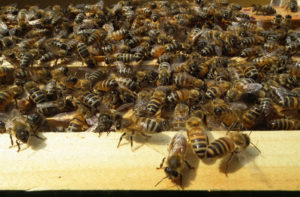This post is also available in: Spanish
Regardless if it’s just a hobby or a constant source of income, the type of the honey bee is by far the most important aspect in beekeeping. Moreover, any hive management scheme will be greatly influenced by the race of the honey bee.
When it comes to types of honey bee, there are three distinctive taxonomies:
- Pure race. According to David Cushman, it is nearly impossible to find a race that is 100% pure as bees were introduced in locations where the nature would have prevented this (oceans and seas, mountains). Therefore, a purity of more than 90% is considered to be excellent.
- Hybrid (genetic or a cross between two sub-species)
- Mongrel. The mongrel is a type of bee where one or both of its parents are a cross. Brother Adam used to describe the mongrel as a creature with unknown pedigree. Basically, the mongrel is an F2 or lower.
Characteristics of the Buckfast Honey Bee
The Buckfast race is the result of the crossing between the Italian Honey Bee (Apis Mellifera Ligustica) and the West-European Honey Bee in England, a sub-species of the Apis Mellifera Mellifera. In time other races were added to the crossing. The creation of the Buckfast bee started in 1914, right before the local bee was eradicated by an epidemic.

The color of the Buckfast bee is described by its creator, Brother Adam, as being similar to the old Italian Honey Bee, whose color was darker than nowadays. However, the selection was never carried out in order to obtain a color uniformity, as this would have had a negative impact on other more important traits. This is the reason for the lack of uniformity in color of the Buckfast bee. When it comes to characteristics that directly impact the performance and economical value of the race, the uniformity is excellent.
Among these qualities we can name the very prolific queens, the very low swarm instinct, gentleness and a high resistance to diseases. It also produces less propolis than other races, overwinters extremely well, using less honey stores, great honey producers, builds up rapidly in the spring while maintaining a strong colony during the entire summer. It’s probably the most gentle bee of all the races, allowing the beekeeper to work with minimal use of smoke and in bad weather.
The most important trait of a bee race has to be a low swarming instinct. All the other strong points are useless if a race has a high tendency to swarm. Swarming is one of the biggest challenges of the modern beekeeper. Even if the Buckfast Bee has the lowest swarming instinct, it would be a mistake to assume that it won’t swarm regardless of the circumstances. There simply isn’t a bee with no swarming instinct.
There are of course some races that will be inclined to swarm despite all the precaution measures taken. That;s certainly not the case with the Buckfast Honey Bee. A pro beekeeper, tending to more than 2000 Buckfast colonies, said that when working properly with it, the Buckfast Bee has a swarming instinct so low that it becomes unfeasible to carry out periodical control visits. Based on our experience in working with the Buckfast Bee, as well as from the feedback of our customers, we can confirm this without any doubts. A quality Buckfast Honey Bee will swarm only under exceptional conditions.
All of these excellent traits of the Buckfast Honey Bee are a manifestation of the heterosis qualities of a hybrid.
Below you’ll find all the links to the articles from this mini-series:
- The Buckfast Honey Bee
- The Italian Honey Bee
- The Carniolan Honey Bee
- The Caucasian Honey Bee
- The Carpathian Honey Bee
Foto header: Flickr




The Carpathian Honey Bee. Characteristics and recommendations • ApiExpert
[…] The Buckfast Honey Bee […]
Selecting the Apiary Site • ApiExpert
[…] we previously talked about the different races of honey bees and how to choose one that best suits your needs, we […]